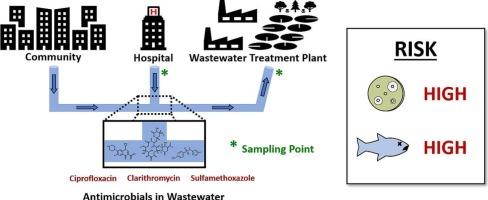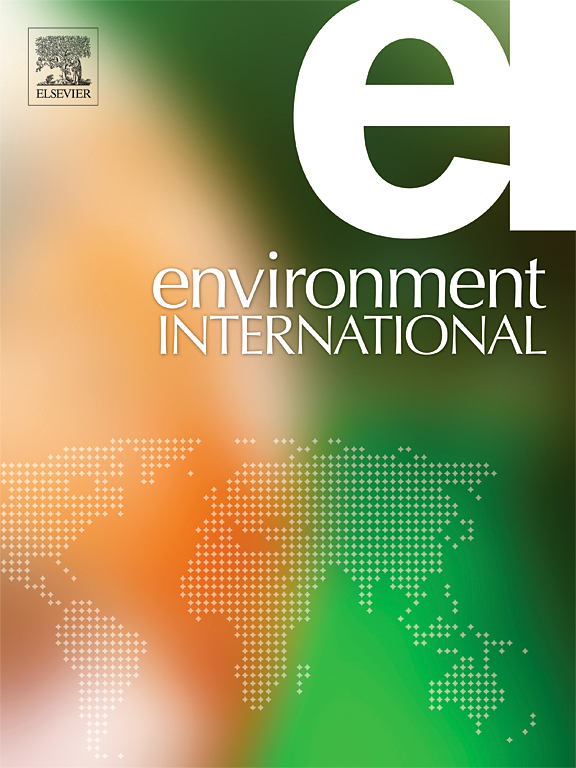Assessing the risk of antimicrobial resistance and potential environmental harm through national-scale surveillance of antimicrobials in hospital and community wastewater
IF 9.7
1区 环境科学与生态学
Q1 ENVIRONMENTAL SCIENCES
引用次数: 0
Abstract
Antimicrobial resistance (AMR) is a major public health concern. Antimicrobial residues enter wastewater where their continued presence can lead to an increased risk of AMR while also causing environmental harm when untreated wastewater is discharged into the environment. This research presents the antimicrobial residue surveillance results of a national-scale wastewater sampling campaign across Wales. Wastewater from 15 sites—effluent from 7 hospitals and influent from 8 community wastewater treatment plants—was collected for 5 consecutive days monthly from May–July 2023. This campaign captured more than 30 % of the Welsh population and over 30 % of the population receiving care as hospital inpatients. Using a quantitative approach, over 175 unique wastewater samples were analyzed by ultra-performance liquid chromatography tandem mass spectrometry (UPLC–MS/MS) for more than 40 antimicrobials including: β-lactams, macrolides, quinolones, sulfonamides, a veterinary antibiotic, an antifungal, antivirals, and numerous metabolites. The most prevalent antimicrobials were clarithromycin, its metabolite N-desmethyl clarithromycin, fluconazole, and trimethoprim as they were detected in all samples. Sulfamethoxazole concentrations ranged from 724–28031 ng/L and trimethoprim ranged from 785–44539 ng/L in hospital effluent—concentrations significantly higher than those reported in published literature. In hospital wastewater, many antimicrobials were present at concentrations which were orders of magnitude higher than their respective predicted no-effect concentrations (PNECs) for antibiotic resistance selection (e.g., metronidazole, trimethoprim). These concentrations create a selective pressure which can drive AMR emergence. Furthermore, some antimicrobials remained at high-risk concentrations even after dilution in community wastewater (e.g., ciprofloxacin, clarithromycin). Environmental risk assessments also identified clarithromycin and ciprofloxacin as agents of concern while vancomycin posed the highest environmental risk (concentrations ca. 1000–38000-fold > PNEC in hospital effluent) should this wastewater enter the environment untreated (e.g., combined sewer overflows). Instances of direct disposal of antimicrobials were clearly identified in hospital wastewater. These results demonstrate the importance of regular monitoring of AMR and potential environmental risk posed by antimicrobials in wastewater, while demonstrating the need for comprehensive national action (e.g., treatment of hospital wastewater on-site, tertiary/quaternary treatment of community wastewater, tailored stewardship programs, focussed control efforts on high-risk antimicrobials) to minimize risks to public health and the environment.


通过在全国范围内监测医院和社区废水中的抗菌素,评估抗菌素耐药性风险和潜在的环境危害
抗菌素耐药性(AMR)是一个重大的公共卫生问题。抗菌药物残留物进入废水,其持续存在可能导致抗菌素耐药性风险增加,同时当未经处理的废水排放到环境中时也会造成环境危害。本研究提出了抗菌残留监测结果的全国规模的废水取样运动在威尔士。从2023年5月至7月,每月连续5天收集15个地点的废水——7家医院的废水和8个社区废水处理厂的进水。这一运动覆盖了30% %以上的威尔士人口和30% %以上作为住院病人接受治疗的人口。使用超高效液相色谱串联质谱(UPLC-MS /MS)分析了超过175种独特的废水样品,其中包括40多种抗菌剂,包括β-内酰胺类、大环内酯类、喹诺酮类、磺胺类、兽药抗生素、抗真菌药物、抗病毒药物和许多代谢物。在所有样品中检测到的最普遍的抗菌剂是克拉霉素、其代谢物n -去甲基克拉霉素、氟康唑和甲氧苄啶。医院废水中磺胺甲新唑的浓度范围为724-28031 ng/L,甲氧苄啶的浓度范围为785-44539 ng/L,显著高于已发表文献报道的浓度。在医院废水中,许多抗菌素的浓度比抗生素耐药性选择(如甲硝唑、甲氧苄啶)的预测无效应浓度(PNECs)高出几个数量级。这些浓度产生了一种选择性压力,可以推动抗菌素耐药性的出现。此外,一些抗菌剂即使在社区废水中稀释后仍处于高风险浓度(如环丙沙星、克拉霉素)。环境风险评估还确定克拉霉素和环丙沙星是令人担忧的物质,而万古霉素如果进入环境(例如,合流下水道溢流),则构成最高的环境风险(医院废水中浓度约为1000 - 38000倍 >; PNEC)。在医院废水中明确发现了直接处理抗菌素的实例。这些结果表明了定期监测抗菌素耐药性和废水中抗菌素造成的潜在环境风险的重要性,同时表明需要采取全面的国家行动(例如,现场处理医院废水,社区废水的三级/四级处理,量身定制的管理方案,重点控制高风险抗菌素),以尽量减少对公众健康和环境的风险。
本文章由计算机程序翻译,如有差异,请以英文原文为准。
求助全文
约1分钟内获得全文
求助全文
来源期刊

Environment International
环境科学-环境科学
CiteScore
21.90
自引率
3.40%
发文量
734
审稿时长
2.8 months
期刊介绍:
Environmental Health publishes manuscripts focusing on critical aspects of environmental and occupational medicine, including studies in toxicology and epidemiology, to illuminate the human health implications of exposure to environmental hazards. The journal adopts an open-access model and practices open peer review.
It caters to scientists and practitioners across all environmental science domains, directly or indirectly impacting human health and well-being. With a commitment to enhancing the prevention of environmentally-related health risks, Environmental Health serves as a public health journal for the community and scientists engaged in matters of public health significance concerning the environment.
 求助内容:
求助内容: 应助结果提醒方式:
应助结果提醒方式:


